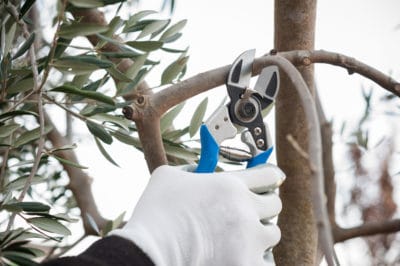Reasons for Pruning an Olive Tree
Most fruiting trees need pruning, and the olive tree is no exception. Pruning does several important things for a tree, including:
- Spurs fruit production.
- Stops trees from bearing fruit in alternate years.
- Makes it easier to harvest the crop.
- Keeps the tree growing vigorously by letting light into the interior of the canopy.
- Helps maintain a strong branch structure.
- Limits the size of the tree, making it easier to pick.
When to Prune Olive Trees
Do not prune your olive trees until they are four years old. Pruning earlier removes leaves, and leaves are how a tree produces the needed energy to grow.
Annual pruning of olives can be done in early spring through the flowering stages and also latter in summer. Pruning should be done after rains have ended, because wet conditions can encourage disease problems.
How to Prune Olive Trees
Before you get out the loppers and start cutting away, be sure you understand the difference between heading and thinning cuts. These two types of pruning cuts have the opposite effect, and it is important to know the difference.
Heading cuts are cuts made at the point on a branch where a vegetative bud is growing. These types of cuts encourage growth in branches and twigs behind the cut. When done properly, heading cuts make the tree bushier and can encourage fruiting in lateral branches.
Thinning cuts entirely remove a branch where it grows out of another branch. This type of cut reduces foliage and also fruit, but it allows light and air circulation to enter the interior of the tree, keeping the tree healthy.
Making a few, carefully selected cuts is better than trimming too much. Heavy pruning can damage a tree’s fruit production for years to come.
Start by trimming out any shoots growing up from the root stock. Next, cut out any diseased, dead, broken, and crossing branches. Make the cut on the branch at the bottom where it attaches to the trunk or another branch, and don’t leave a stub.
Also, look for a slightly raised area at the base of any branch you trim-off and leave this area, called the branch collar. The branch collar produces important hormones which allow the tree to heal from the cut.
Use thinning cuts to limit the height of the tree and to remove a few branches from the interior, so sunshine can enter.
